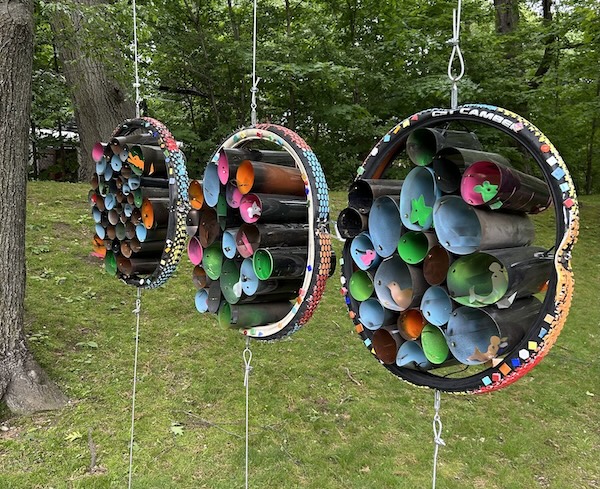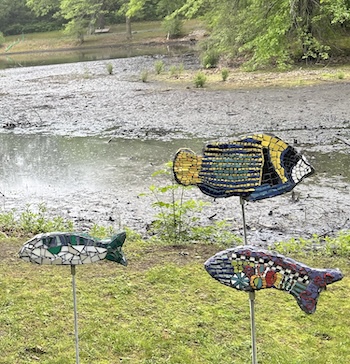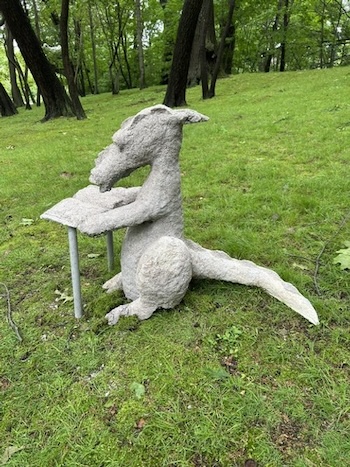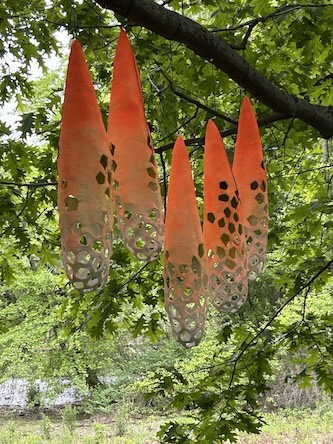By Lauren Kaufmann
Viewing the art while strolling along the Muddy River gives city-dwellers and visitors a reason to linger and enjoy one of the city’s oldest and most beautiful open spaces.
Dream Upon the River, Studios Without Walls, Emerald Necklace Riverway Park, on display through September 1

Dream Finder, Bette Ann Libby, 2025. Photo: courtesy of Bette Ann Libby
Boston is blooming with public art. Springtime offers area artists a variety of outdoor venues, and the Emerald Necklace, the city’s oldest chain of parks, provides a perfect setting. Designed by Frederick Law Olmsted in the late 1800s, the parks are lined by majestic old trees, and the paths are humming with activity. They offer a lovely, leafy environment for local art.
Studios Without Walls, a Brookline nonprofit, is sponsoring Dream Upon the River, its 26th annual exhibition. Twenty-one local artists have created site-specific works of art that will remain on view at Riverway Park throughout the summer.
This free exhibition boasts a variety of works, and each piece is accompanied by an interpretive panel supplying information about the artist and their source of inspiration. Viewing the art while strolling along the Muddy River gives city-dwellers and visitors a reason to linger and enjoy one of the city’s oldest and most beautiful open spaces. There are plenty of benches along the way that offer a place to rest your feet and soak in a sunny day, read a book, or catch up with a friend.

Fish Sticks, Cassie Doyon, 2025. Photo: courtesy of Bette Ann Libby
Many of the artists use the setting in creative ways. While some attach their artwork directly to tree limbs, other artists place their pieces on the banks of the river, taking full advantage of the light reflecting off the water to illuminate their work. Cassie Doyon’s Fish Sticks features seven mosaic fishes mounted on sticks inserted in the ground in front of the river. Doyon grew up in a seaside town and has drawn on the ocean in much of her artwork. She enjoys making what she calls “color and texture memories” of places that she’s visited. Her school of fish is a delightful, colorful assemblage.
Barbara Fletcher has created Cloud Dreaming, a group of dreamy animals suspended from a tree limb. Made out of spray foam, fabric, wire, and nylon netting, these fanciful figures are part-cloud, part-animal. They conjure up memories of lazy summer days lying on a grassy field, staring up at the clouds, while tracking magical formations drifting across the sky.
Bette Ann Libby also hung her work, Dream Finder, from a tree. Libby has taken three bicycle tires and festooned them with rolled-up MRI films. She’s made miniature imaginary creatures and placed them inside the films. She’s adorned the tires with bright swatches of color; the overall effect of her work is light and whimsical.
Adrienne Shishko and Suzanne Moseley of MOSH Studio collaborated on Glacial Ghost. In a series of block-like forms, the duo uses repurposed materials from reclaimed fishing gear and waste streams. The pieces are made out of polystyrene (Styrofoam) that was picked up by the Provincetown-based Center for Coastal Studies and several Boston-based coastal agencies. The artists hope to inspire viewers to consider their buying (and discarding) habits more carefully when they think about protecting the environment.

Dragons Love to Read, Dawn Evans Scaltreto, 2025. Photo: courtesy of Bette Ann Libby
Ania Gilmore’s Chair-ish is made up of a circle of eleven vintage chairs and has been designed to convey the need to find time for dialogue in our divided time. Gilmore painted the chairs red — to emphasize the urgent demand for communication. The seat-less chairs evoke an empty feeling, critiquing our current lack of commitment to conversation. The result underlines our cultural distance and divisiveness.
In Dragons Love to Read, Dawn Evans Scaltreto has fashioned a concrete sculpture of a dragon reading a book. Her work is small and low to the ground, sited in front of a tree. Scaltreto says she loves to create whimsical art for children and adults, and the scale of this piece is perfect for little ones exploring the exhibition.
Anna Kristina Goransson has produced a grouping of five teardrop-shaped orange pods that she calls Imagining the Future. Hanging from a tree limb in front of the water, her piece speaks to a future time when humans are gone and huge seeds grow into enormous plants. Made of felted wool and spray paint, her luminous creations look lovely in the sunlight, despite the somewhat dystopian theme of the work.
Like You and Me also plays with the park’s natural light. Created by the team of Claudia Ravaschiere and Michael Moss, this piece is comprised of several reflective domes made of mirror-treated acrylic. The hemispheric domes pop out of the ground and invite viewers to come closer. As you approach one of the domes, you see yourself and the trees reflected back. The artists’ statement alludes to the symbolic meaning of the dome as a link between heaven and earth. The duo says that they were inspired to create a piece that embodies our connection to earth, and to each other.
Pam Kainz’s piece, Endurance, is an arrangement of 12 tree root bases collected from cedar trees in local forests. Even though cedar has a natural oil that prevents decay, Kainz used a torch to char the wood because it would protect and preserve each base. She’s organized the group on the grassy river bank, with each root possessing a distinctive shape and form. Together, the roots resemble remnants of a loosely arranged group of people, hanging out, chattering, or just taking in the view. In making this piece, Mainz reflected on the underground network of roots that connects the trees, comparing these invisible links to the ties that bind people together.

Imagining the Future, Anna Kristina Goransson, 2025. Photo: courtesy of Bette Ann Libby
In Diverging Dreams, Liz Helfer gathered together powder-coated steel, windshield glass, and acrylic to create a sculpture made up of fragmented pieces and primary colors. The multiplicity is symbolic of the many paths our lives can take. In her statement, Helfer says, “Embrace the unexpected detours, for the journey itself is as important as the destination.”
Helfer’s advice lends itself well to this exhibition, where park visitors will come across a diverse lineup of artwork that they may not have expected. Pedestrians, cyclists, and runners may find themselves slowing down to take in the serendipitous assemblage of art. Viewers may well be struck by the varied creativity of local talent.
Dream Upon the River is hosted by the Brookline Department of Public Works and the Parks and Open Space Division. The exhibition is organized by Studios Without Walls, which has created a self-guided tour and art treasure hunt. Look for both in the red info boxes along Riverway Park.
- To get to Riverway Park via public transportation, take the Green Line D Branch, and get off the train at the Longwood stop. There’s a walkway from the stop that will take you to the park.
Lauren Kaufmann has worked in the museum field for the past 14 years and has curated a number of exhibitions. She served as guest curator for Moving Water: From Ancient Innovations to Modern Challenges, currently on view at the Metropolitan Waterworks Museum in Boston.